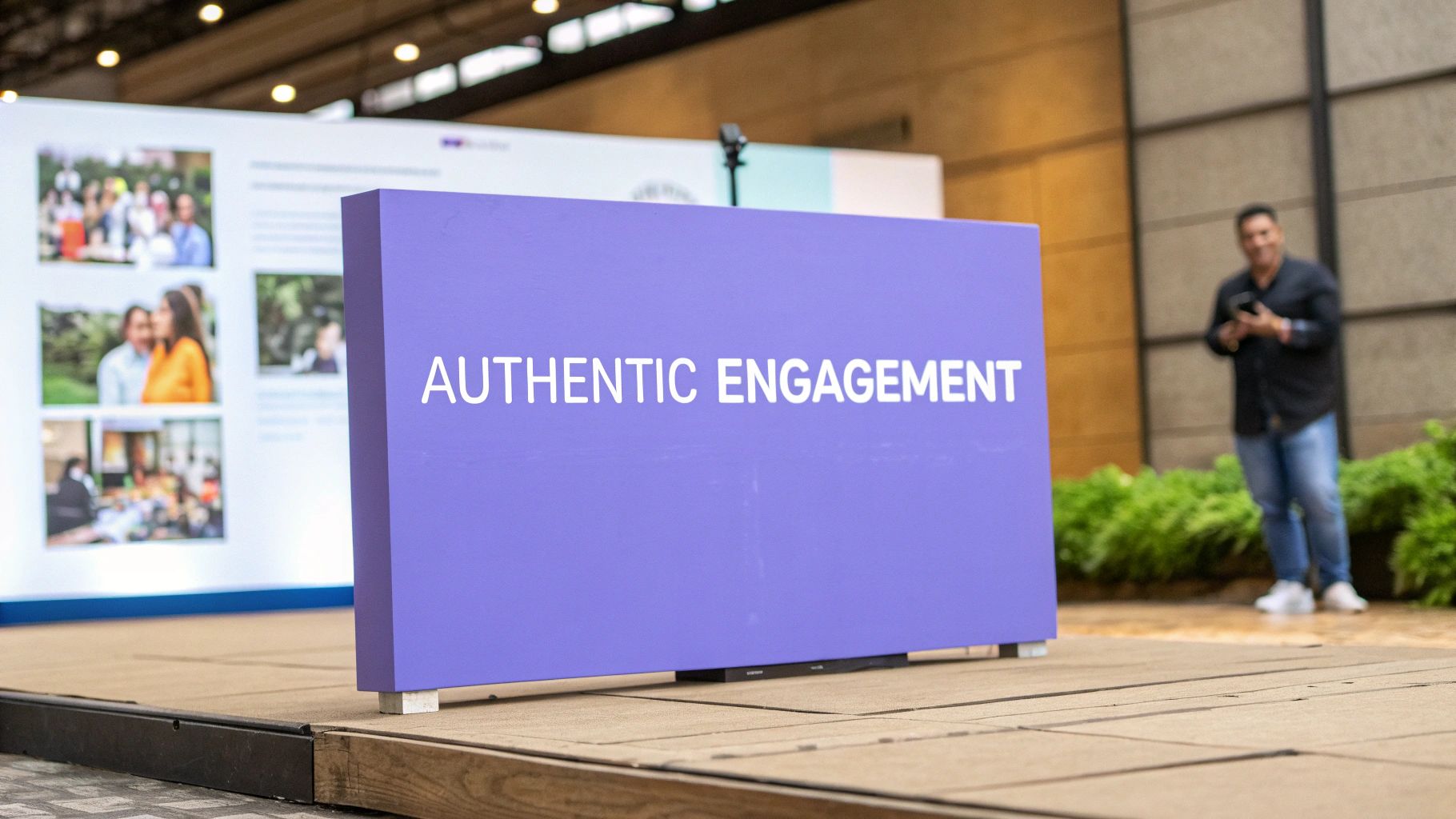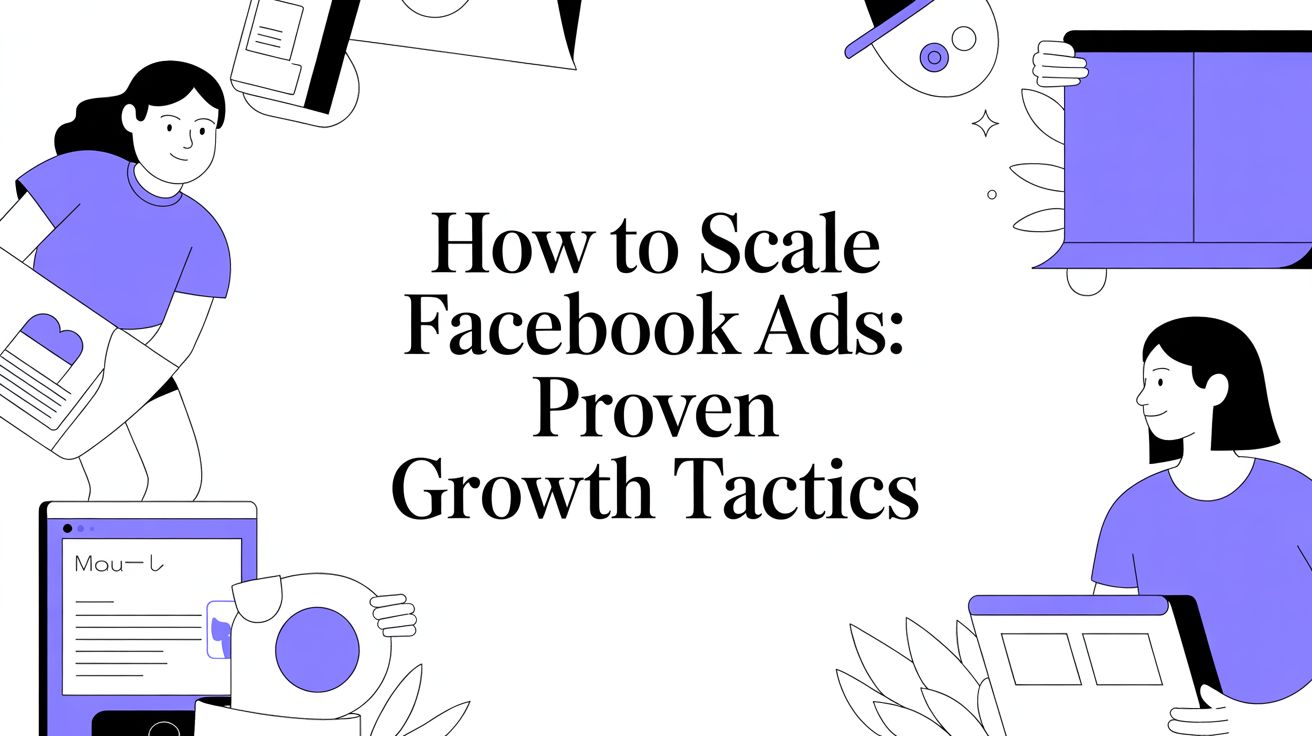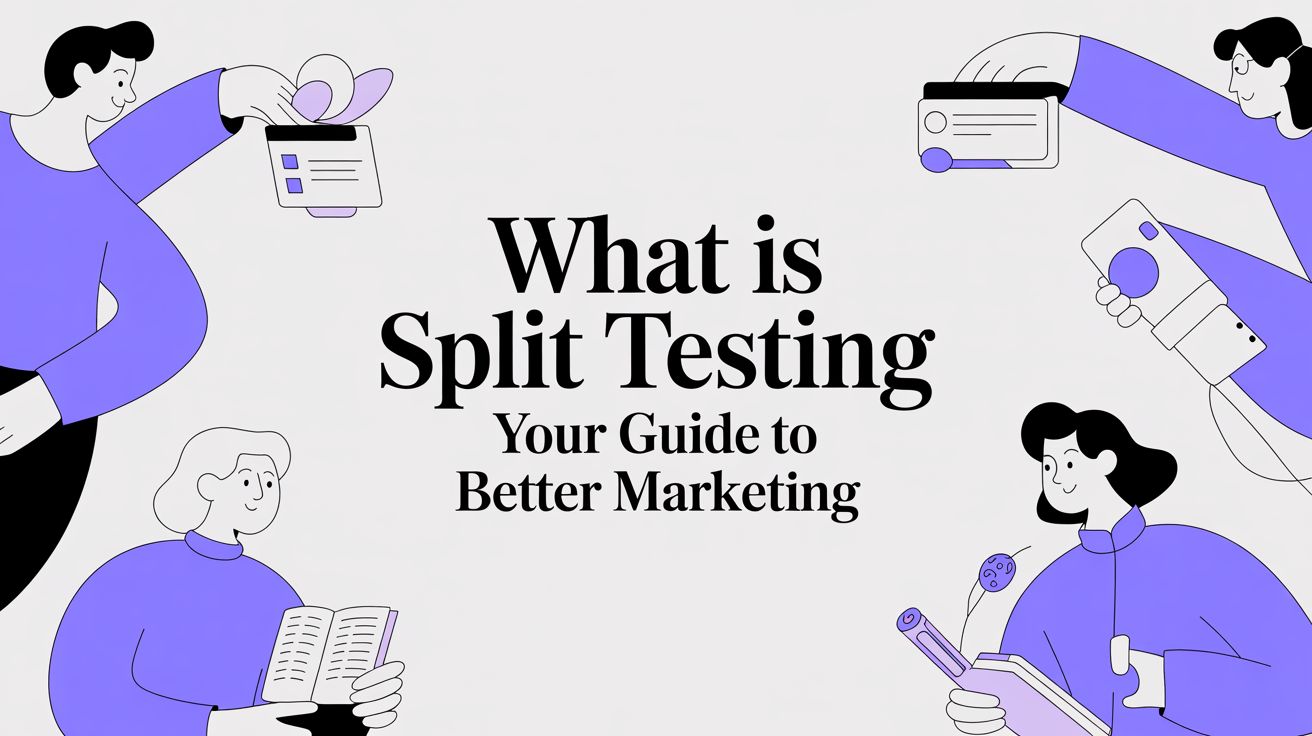Imagine the difference between a slick, big-budget TV commercial and a real, funny, or heartfelt video a friend sends you. That’s the magic behind AI UGC ads. It’s a method that takes genuine videos and photos from real customers—what we call user-generated content (UGC)—and uses smart technology to turn them into ads that people actually trust and enjoy.
It’s about finding the best customer content out there and getting it in front of the right people, automatically.
The New Wave of Authentic Advertising
Let's be honest. We’re all tired of ads. We've seen so many polished, corporate messages that we’ve developed a sixth sense for spotting a sales pitch. We crave something real, something we can connect with. This is why user-generated content is so powerful. It's not a brand talking at you; it's a real person sharing their experience. It feels like a recommendation from a friend.
But here’s the catch: finding great UGC used to be a huge headache. For every amazing customer video, you'd have to sift through a mountain of duds. It was a slow, manual, and often frustrating process. This is the exact problem that AI comes in to solve.
Think of AI as your super-smart assistant. It instantly scans thousands of pieces of content to pinpoint the ones that are most likely to grab attention and get people talking—before you even think about spending money on an ad campaign. It takes the guesswork out of the equation.
Why This Matters Now
This move towards user-led content isn't just a passing fad. It represents a massive shift in how advertising works. In fact, by 2025, it's predicted that user-generated content will pull in more ad revenue than professionally produced content. You can dig into the numbers yourself by reading the full WPP Media forecast. This shows just how much brands are starting to rely on the genuine connection that these ads create.
This change is happening for a simple reason: authenticity sells. Combining AI with UGC solves two of the biggest challenges for marketers today:
- Trust: People trust other people more than they trust brands. AI helps you find and amplify those trusted voices.
- Scale: Manually sorting through UGC is practically impossible for most teams. AI makes the whole discovery and approval process manageable and scalable.
At the end of the day, AI UGC ads close the gap between what brands want to say and what customers actually want to hear. It’s a way to connect with today’s smart consumers on their level, building credibility and driving real results in a way that old-school advertising just can’t anymore.
To see these differences side-by-side, let's break it down in a quick comparison table. This really highlights the shift from the old way of doing things to this new, more effective approach.
Traditional Ads vs AI UGC Ads At a Glance
| Attribute | Traditional Ads | AI UGC Ads |
|---|---|---|
| Creator | Professional agency or in-house team | Real customers and creators |
| Tone | Polished, scripted, corporate | Authentic, unscripted, relatable |
| Cost | High production and talent costs | Low to no content creation cost |
| Creation Speed | Weeks or months | Hours or days |
| Trust Factor | Low; often viewed with skepticism | High; seen as a peer recommendation |
| Performance | Can be hit-or-miss, quick to fatigue | Consistently higher engagement and conversion |
| Scalability | Difficult and expensive to scale | Easy to scale with AI content discovery |
As you can see, the move to AI UGC ads isn't just about following a trend. It's a strategic decision to create advertising that is faster, cheaper, more trustworthy, and ultimately, more effective at connecting with modern audiences.
How AI Supercharges Your UGC Ads
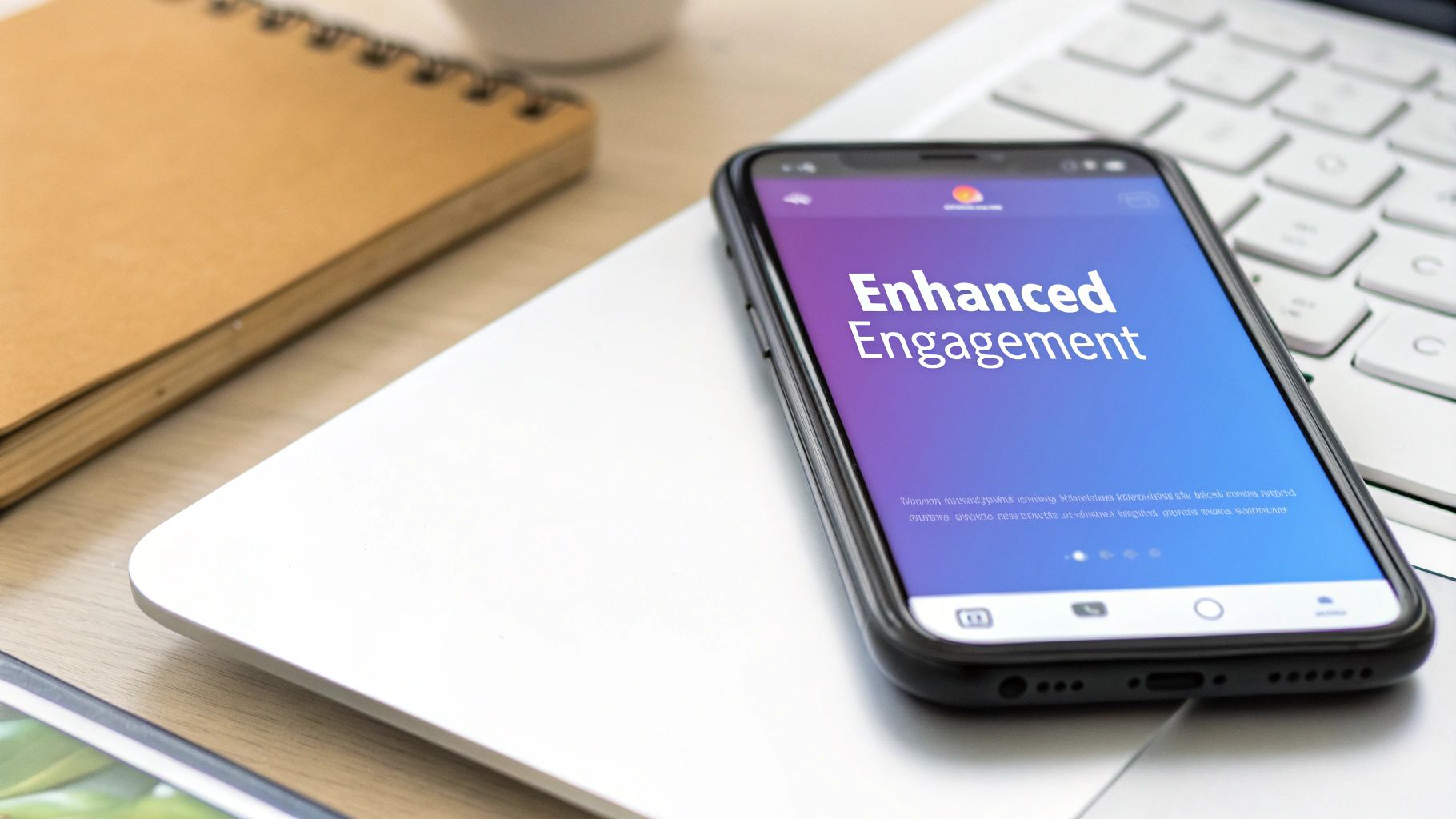
Think of all the user-generated content out there as a giant, messy pile of gold ore. It’s packed with genuine customer reactions and authentic moments, but digging through it all to find the few nuggets that will make a killer ad is a huge job. This is where AI comes in. It acts like a high-tech sorting machine, sifting through all that raw material with incredible speed and accuracy.
AI doesn’t just find content; it actually understands it. These algorithms can analyze thousands of videos at once, spotting the key ingredients that hint at high engagement. It turns a manual, painfully slow chore into a smart, data-backed strategy for creating winning AI UGC ads.
From Chaos to Clarity with AI
If you’ve ever tried to manually find great UGC on TikTok, Instagram, or YouTube, you know it’s like searching for a needle in a global haystack. Brands usually hit three big walls: the overwhelming amount of content, the guesswork involved in predicting what will perform, and the headache of getting permission to use it.
AI tackles each of these problems head-on, transforming a chaotic process into a clear, straightforward workflow.
Solving the Scale Problem: An AI can analyze thousands of videos in the time it takes a person to get through a handful. It never needs a coffee break and can scan for specific visuals, audio tones, and performance metrics 24/7.
Predicting What Works: By looking at historical data, AI models can make surprisingly accurate predictions about a video's potential. They spot the patterns in past content that drove tons of engagement, clicks, or sales for audiences just like yours.
Making Rights Management Easy: Instead of having your team hunt down creators, modern AI platforms can automatically identify the original poster and start the conversation about usage rights. This automates a tedious but critical step, getting your campaigns live much faster.
The goal here isn't to replace your marketing team's creativity. It's about taking the grunt work off their plate so they can focus on big-picture strategy. AI handles the discovery and analysis, augmenting human insight with powerful data.
This isn’t just a futuristic idea; it’s happening right now. For many marketers, AI is already a core part of their toolkit. One study found that 90% of content marketers are planning to use AI to support their work. The same report showed 71.7% already use it for outlining content and 68% for brainstorming ideas, which proves how deeply it’s becoming part of the creative process. You can dig into more stats on this in Siege Media's recent AI writing report.
The Real-World Impact on Ad Creation
Bringing AI and UGC together completely changes the ad creation game. Forget about spending weeks and a small fortune producing one glossy, polished ad. Now, brands can test dozens of authentic, low-cost UGC clips that an AI has already flagged as promising.
This means you find out what your audience truly connects with faster than ever. If a certain creator's vibe or a particular video style is getting great results, the AI can then go find more content just like it. You can quickly double down on what’s working and scale your campaigns without the guesswork.
Building Your First AI UGC Ad Campaign
Alright, let's move from theory to practice. This is where the fun really starts. Launching your first AI-powered UGC ad campaign might sound intimidating, but it’s actually a straightforward process broken down into a few logical steps.
To make this real, let's follow a hypothetical example: a skincare brand that’s just launched a new vitamin C serum. They want to find genuine customer videos to fuel their upcoming TikTok and Instagram ads.
Here’s how they’d do it.
Stage 1: AI-Powered Content Discovery
First things first, you need the raw materials. Instead of a team member endlessly scrolling through social media feeds, the brand uses an AI platform to do the heavy lifting. They simply input what they're looking for: hashtags like #VitaminCSerumGlow, brand mentions, and keywords about skincare routines.
The AI immediately gets to work, scanning thousands of public videos. It’s not just matching keywords; it’s looking at visual quality, checking audio clarity, and even gauging the sentiment of the person in the video. In a matter of hours, it presents a library of potential UGC clips—a task that would take a human team days, if not weeks.
Stage 2: Predictive Curation and Selection
With a pool of content found, the AI’s job shifts from discovery to analysis. It starts scoring each video based on its potential to perform well as an ad. By analyzing data from millions of previous ads, the algorithm knows what to look for—things like clear product shots, authentic excitement from the creator, and a strong hook in the first three seconds.
The platform then gives the skincare brand a curated shortlist of the top 10-15 videos that are most likely to get clicks and drive sales. This data-backed approach takes the guesswork out of creative selection, letting the marketing team focus their energy on the clips with the highest chance of success.
This image shows a simplified view of how raw user content gets transformed into a polished, high-impact ad.
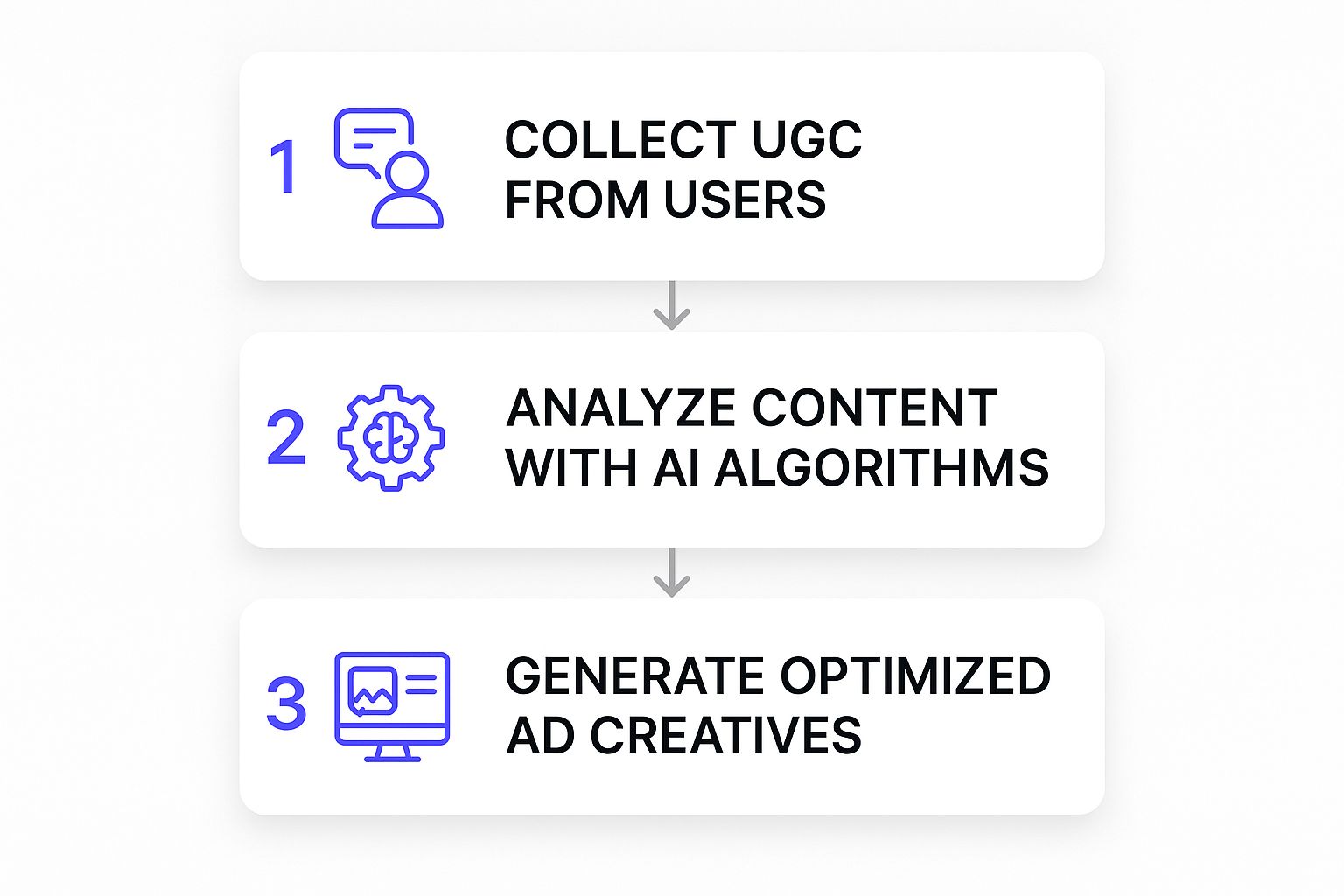
As you can see, the AI acts as the smart connector, bridging the gap between authentic user posts and optimized ads ready for launch.
Stage 3: Automated Creator Outreach
Once the best videos are picked, the brand needs permission to use them. Tracking down creators and sending DMs one by one is a huge time-sink. This is another area where AI platforms are a game-changer.
The system can automatically send personalized outreach messages to the creators. It explains that the brand loved their video and makes an offer to license the content for advertising. This streamlined workflow can handle the initial contact, the negotiation, and even the payment, making sure everything is handled legally and above board.
This process sits at the intersection of UGC and influencer marketing. If you want to dive deeper, you can explore our guide to AI influencer marketing.
Key Takeaway: The point here isn't to replace people. It's to give them superpowers. By automating the tedious discovery and rights management, marketers are freed up to focus on what really matters: creative strategy and campaign performance.
Stage 4: Smart Campaign Optimization
With the rights secured, it's time to go live. The skincare brand can now run A/B tests with multiple authentic video clips to see which message or style truly connects with their audience.
But the AI’s job isn’t over. It continues to monitor the campaign's performance in real time, feeding back data on which ads are hitting the mark. If one creator's video is knocking it out of the park, the system can even identify more content with a similar vibe or find lookalike creators to partner with.
This creates a powerful feedback loop, letting the brand constantly refine its approach and pour more budget into what’s proven to work.
Why Consumers Trust Real Content More
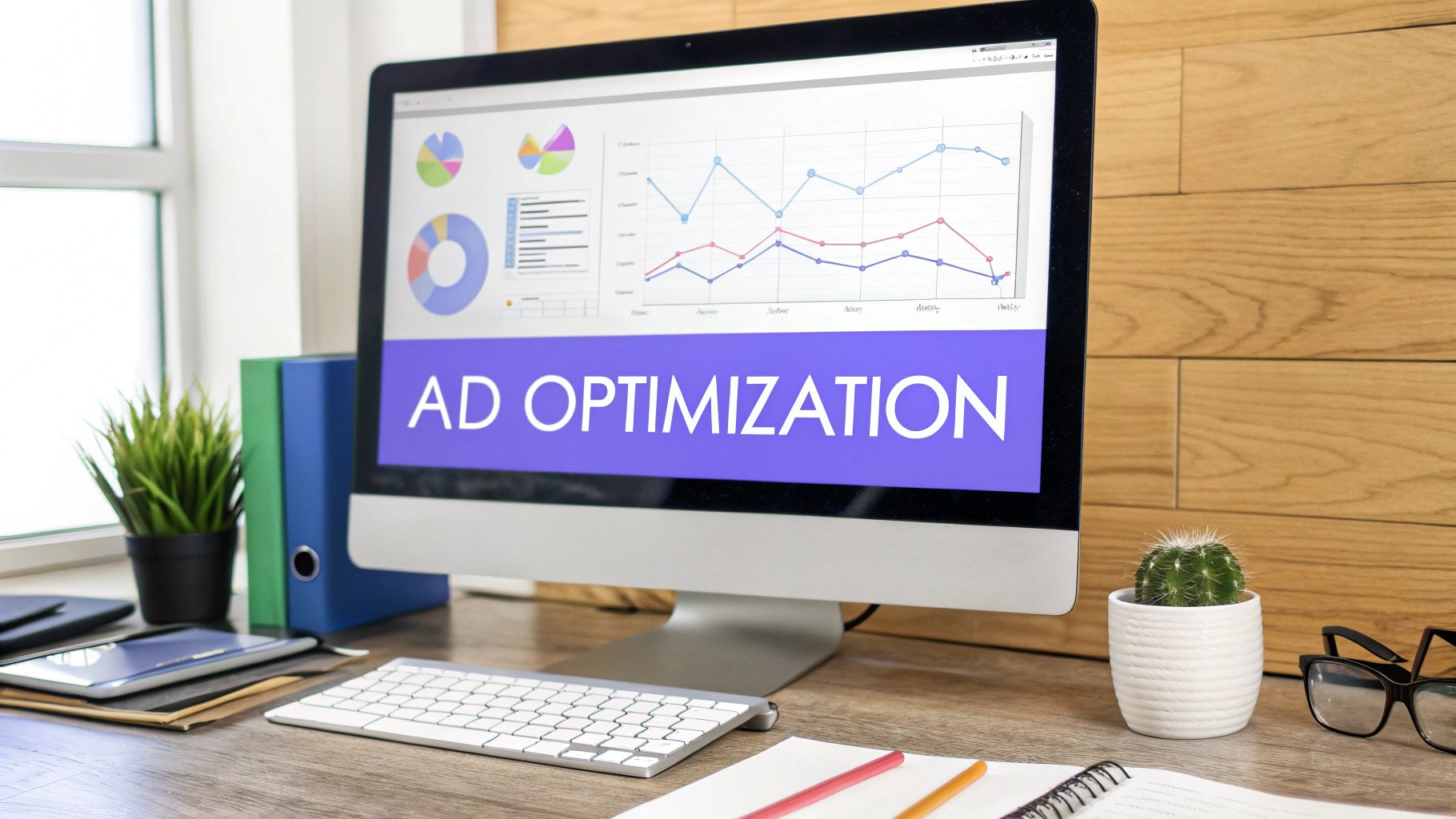
When you get right down to it, advertising has always been about building trust. For a long time, brands did this with slick TV commercials and perfectly polished ad campaigns. But that playbook is getting old. Today’s consumers are drowning in marketing messages, and their trust has moved away from big brands and toward people just like them.
Think about it this way: would you rather try a new cafe because you saw a glossy magazine ad, or because a friend posted a rave review on their Instagram story? It’s the friend, right? That simple idea is called social proof, and it’s the secret sauce that makes user-generated content (UGC) work so well.
UGC is basically word-of-mouth for the digital age, and it’s still the most effective marketing out there. When potential customers see real people—not paid actors—actually using and loving a product, it creates an instant connection. It’s a level of authenticity that traditional, brand-made content just can't replicate.
The real power of UGC is that it doesn’t feel like a sales pitch. It feels like a shared experience. It slips past the natural skepticism we all have for ads because it comes across as genuine advice from someone you can relate to.
The Data Doesn't Lie
This isn't just a gut feeling; the numbers back it up. In today’s ad world, authentic content created by real people consistently blows traditional ads out of the water on every major platform. For instance, Instagram posts with UGC are on track to get 70% more engagement than standard brand posts by 2025. Over on TikTok, UGC is already beating brand-created content by about 22% in sheer effectiveness.
These stats paint a very clear picture. People aren't just passively watching content from their peers; they’re engaging with it, sharing it, and ultimately, letting it guide what they buy.
How Trust Turns into Better ROI
So, how does all this trust actually make your business more money? The connection is surprisingly direct. More trust leads to more engagement, and more engagement leads to better conversion rates. When you use AI UGC ads, you’re able to tap into this authentic connection on a massive scale.
Here’s a simple breakdown of how trust directly helps your bottom line:
- Higher Credibility: An ad featuring a real customer is immediately more believable, which makes it easier for someone to decide to buy.
- More Engagement: People are more likely to like, comment on, and share content they can relate to. This expands your reach organically without you spending an extra dime.
- Better Conversions: A trusted recommendation is far more persuasive than a corporate slogan, leading to more clicks and, ultimately, more sales.
This creates a positive feedback loop. An AI-driven approach helps you continuously find and feature the most trustworthy content, making sure every dollar you spend on ads is working to build real connections with people. To get the full picture, you can check out our detailed guide on https://sprello.ai/blog/user-generated-content-ads. This is more than just making ads; it's about building a brand that customers truly believe in, one authentic story at a time.
Choosing the Right AI UGC Platform
With so much buzz around AI-powered advertising, a flood of new tools has hit the market, all promising to make creating AI UGC ads a breeze. It's easy to get overwhelmed by the options, but picking the right platform becomes much simpler when you focus on what your brand actually needs. It’s not about finding the tool with the longest feature list; it’s about finding the one that solves your real-world problems.
Think of it like buying a car. A two-seater sports car looks great and goes fast, but it’s useless if you need to haul lumber. You need a pickup truck for that job. In the same way, the best AI UGC tool is the one that fits your campaign goals, your team's workflow, and your budget.
Core Features to Evaluate
When you start comparing platforms, try to look past the flashy marketing claims. Focus on the practical features that will make a real difference in your day-to-day work and, ultimately, your campaign results.
Here are the essential things to look for:
- How It Finds Content: Where does the platform get its UGC? Does it scan social media like TikTok and Instagram for hashtags and brand mentions? Or does it rely on generating new content with AI avatars? You need to know its primary source.
- Performance Prediction: A good platform doesn't just collect content; it helps you figure out what will actually work. Look for tools that analyze clips and give you a data-backed score or ranking based on how likely they are to get clicks and conversions.
- Creator and Rights Management: How does the platform handle contacting creators and securing permission to use their content? Automated rights management is a game-changer here—it cuts down on legal headaches and lets you launch campaigns much faster.
- Ad Platform Connections: The tool should plug right into the ad platforms you already use. Check for direct integrations with Meta Ads, TikTok Ads Manager, and others to make launching and tracking your ads a seamless process.
This snapshot of the Sprello dashboard shows how a simple, clean interface can make it much easier to turn your assets into winning ads.
A straightforward layout like this means marketers can jump in, manage projects, and create different ad versions without needing weeks of training.
Making the Right Choice for Your Brand
At the end of the day, the best choice is always tied to your specific situation. An e-commerce store might need a platform that’s fantastic at uncovering organic video reviews of its products. A B2B software company, on the other hand, might get more value from a tool that can generate polished testimonials using AI actors. As you explore adding AI to your marketing, checking out a list of the top AI marketing software solutions can give you a great starting point.
The most powerful platform is the one your team will actually use. Prioritize a simple interface, strong customer support, and a pricing model that scales with your business.
Remember, the goal of these tools is to help you scale your authentic voice, not replace it. Getting this right pays off big time. Genuine content builds the kind of trust that drives conversions far better than a polished, traditional ad ever could. To see just how big that impact can be, it's worth learning about the core benefits of user-generated content and how they directly boost your ROI.
Proven Best Practices for AI UGC Ads

Alright, let's talk about turning all this theory into actual results. Knowing what AI UGC ads are is one thing, but making them work for your brand requires a solid game plan. Think of these best practices as your playbook for running campaigns that don't just look good but actually deliver.
Before you even think about finding content, you need to know what you're aiming for. What does success look like for this campaign? Are you trying to get your name out there, drive immediate sales, or get more people to download your app? Nail down your specific goals and key performance indicators (KPIs) first. This single step will shape every decision you make down the line.
When you're ready to work with creators, give them room to breathe. The whole point of UGC is that it feels real and unscripted. If you hand them a rigid script, you'll suck the life right out of the content, and it will just end up feeling like another clunky ad. Instead, give them a flexible brief with some general guidelines and let their personality take the lead.
Key Takeaway: The goal is to steer, not to script. A good brief inspires creativity and results in content that feels like a genuine recommendation, not a stilted advertisement. This balance is crucial for maintaining the trust that makes UGC so effective.
Testing and Avoiding Common Pitfalls
So, you've got your content. Your job isn't done yet—it's just getting started. You need to test, test, and test again. Pit different video clips, opening hooks, and calls-to-action against each other. One of the biggest advantages of using AI is the sheer volume of content you can source. Use that to your advantage to quickly learn what your audience loves and put your ad spend behind the winners.
It's just as important to know what not to do. I’ve seen brands make the same mistakes over and over again. Here are the big ones to watch out for:
- Using Content Without Permission: This is the cardinal sin. You absolutely must have clear, documented permission from the original creator before you ever run their content as a paid ad. No exceptions.
- Over-Editing the Content: Don't polish the authenticity away. Slapping on too many flashy graphics, corporate logos, or trying to smooth out every little imperfection can make the ad lose its raw, trustworthy appeal.
- Ignoring Performance Data: The AI can help you find the content, but your ad metrics tell you the real story. Keep a close eye on your data and be ready to change your approach based on what the numbers are telling you.
Got Questions About AI UGC? We’ve Got Answers.
Jumping into AI-powered advertising can feel a bit like exploring new territory, and it's natural to have a few questions. Let's clear up some of the most common ones about getting started with AI UGC ads.
Is It Ethical to Use AI to Find UGC?
Yes, absolutely—as long as it’s done the right way. The key here is transparency and respect for the creator.
Ethical AI tools don't just scrape content from the web without permission. Instead, they use AI to discover great content that already exists. From there, a proper platform helps you start a conversation, get clear consent from the creator, and make sure they're compensated fairly for their work. Think of it as a super-efficient way to find potential partners, not a way to exploit them.
Are AI UGC Ad Tools Affordable for Small Businesses?
They definitely can be. Many of the best AI UGC platforms today were built specifically with small businesses and startups in mind. They often use tiered pricing, so you can start with a plan that fits your budget.
When you factor in the return on investment—UGC ads tend to perform better and cost less to produce than traditional ads—these tools often pay for themselves pretty quickly.
The real magic is in finding 'organic' UGC. This is content someone made simply because they genuinely love a product. That kind of authentic trust is priceless and almost impossible to stage with professional actors, making it a game-changer for brands of any size.
Ready to create high-performing ads in minutes without hiring actors? Sprello uses AI influencers and smart editing to turn your assets into engaging, platform-ready UGC-style videos. Start your free trial at sprello.ai and scale your content today.
